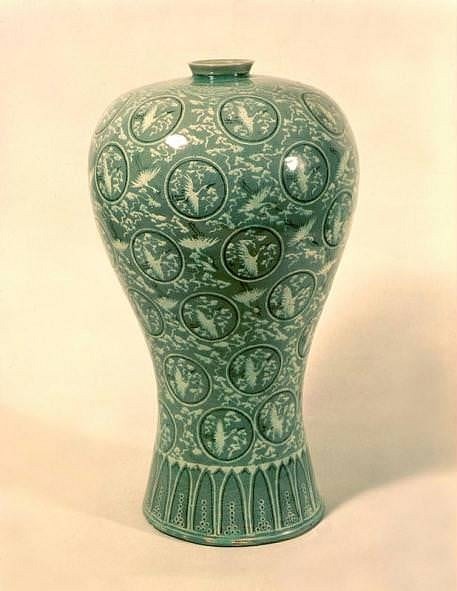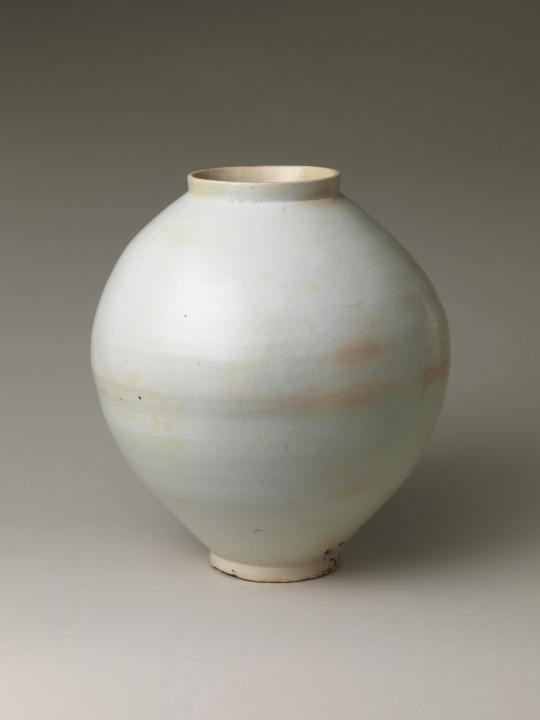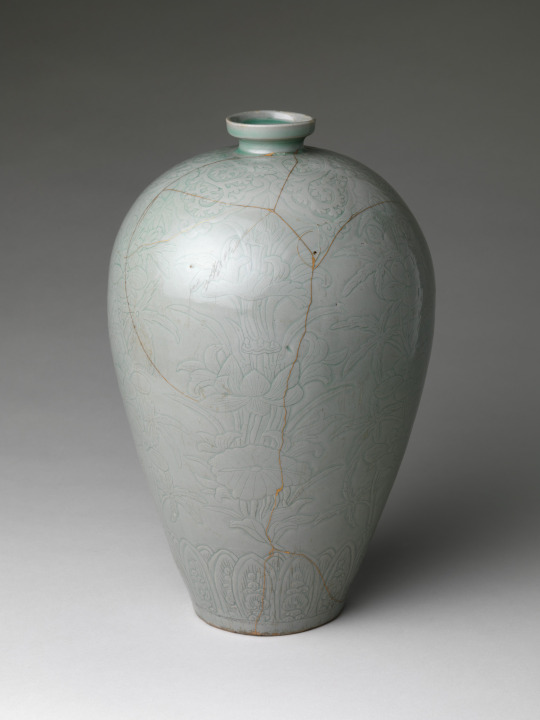#Maebyeong
Explore tagged Tumblr posts
Text

Maebyeong (plum bottle) decorated with cranes and clouds
Korea, second half 12th century
26 notes
·
View notes
Photo

Howard Fonda (American,b. 1974)
Untitled (Hibisus syriacus, Maebyeong deco- rated with lotus, hex sign, Stickley table, Wa- terhouse Wallhanging’s Bissell House wallpa- per, Marie Laurencin’s Femme Peintre and Her Model), 2022
Oil on canvas
126 notes
·
View notes
Text

“Prunus Vase (Maebyeong), 1100-1150.
Goryeo dynasty (918-1392).
Stoneware with iron-painted decoration under celadon glaze, H: 11-1/4 in.; D. 7 in.
The Avery Brundage Collection, Asian Art Museum, Chong-Moon Lee Center for Asian Art and Culture, San Francisco, California.”
7 notes
·
View notes
Photo

Poterie de la Corée Ancienne
La poterie de la Corée ancienne remonte à la préhistoire, à l'époque où l'on fabriquait de simples céramiques brunes décorées d'incisions géométriques. Les potiers se sont inspirés des idées et des techniques de leurs homologues chinois et ont ensuite produit leurs propres œuvres très recherchées, notamment le grès gris, le céladon, le buncheong et la porcelaine blanche. Les céramiques sont de conception innovante et vont des brûleurs d'encens incroyablement complexes à la simplicité et à l'élégance sublimes du vase maebyeong. La décoration de la poterie coréenne utilise généralement des plantes, des fleurs et des animaux sauvages, et reflète l'héritage religieux du pays, avec une prédominance de motifs bouddhistes et de dessins confucéens minimalistes.
Lire la suite...
2 notes
·
View notes
Text
kroeroaeoa
kakakakaka
Korea art: shared aesthetic concepts, motifs, techniques, and forms with art from china and japan yet it also developed a distinctive style on its own. korean art lays in simplicity, spontaneity, and a feeling of harmony with nature Painting: the earliest forms of korean painting found on the fourth century in the form of murals painted on the walls of tombs and graveyards. these murals typically consisted portraits of dead master and his wife and they use the colors black, yellow, purple, green, red, and brown Minhwa: folk painting of korea, the art work of common people from bird and flower paintings to tiger and dragon and the 10 longevity symbols (tigers are depicted funny and friendly in korea in a folk painting of a magpie and a tiger) Most absurd tiger in the world: korea was once "the land of the tigers" but they are nearly extinct today (how ironic). korea used to have so many tigers that they can be found on the country's mountains. A tiger which often comes to villages to consume livestock and even harm people was considered more than an animal by ancient koreans. Minhwa Dragon: it is a sacred animal that chases away evil spirits and protects people from disaster and is a trusted image in the everyday lives of common people Hwajeopdo: it refers to paintings of flowers and butterflies each depicting the exciting natural world which would represent wealth and prosperity but also the common love between a husband and a wife on another. Sculpture(s): Pottery of ancient Korea where simple brown wares were made and decorated with geometrical incisions. its decoration typically uses plants, flowers, and wildlife and reflects the country's religious heritage with buddhist motifs and minimalist confucian designs Kilns: a domestic wares of pottery chambers. Korean Celadon Maebyeong: a maebyeong celadon (greenware) vase from the Goryeo dynasty of ancient korea. design has typical buddhist motifs of cranes and clouds . late 12th century CE Korean neolithic pot: typical pottery bowl from the korean neolithic (new stone) period with pointed base and simple incised decoration Dragon-turtle celadon: a celadon (greenware) ceramic kettle in a form of a mythical dragon-turtle creature. Goryeo dynasty 918-1392 CE Korean Onggi Jars: created since ancient times and used for a multitude of purposes and decoration. its also used to store foodstuffs like soy sauce and fish paste. they are frequently burried in ground and also used as lavatories (toilet) Buncheong Wares: blue-green ceramic covered with a white slip, most practical of korea's offerings to world ceramics Architecture: Naturalistic tendancies, simplicity, economy of shape, and avoidance of extremes. Usually structured vertically and horizontally Muryangsujeon, Buseoksa, Korea: The Muryangsujeon (Murangsu- jŏn) hall, part of the Buseoksa temple complex, Gyeongsangbuk-do Province, South Korea. buddhist temples were first constructed at this site in the 7th century CE but the hall is one of the oldest wooden architectures in korea (goryeo period 918-1392) Cheomseongdae Observatory (Silla): At Gyeongju, the sila capital has the unique mid-7th century CE Cheomseongdae observatory. 9 meters tall, acted like a sundial but also has a south facing window the sun's rays on the interior floor on each equinox. The oldest surviving observatory in east asia Seokgatap Pagoda: part of the bulguksa temple at Gyeongju (seorabeol) sila capital, construction date is 751 CE Korean masks: (question about definiton will pop out in the test) They are called tal or t'al, orginated with religious and artistic meaning, worn to express a certain character, made in a form of human or animal faces
0 notes
Text
Melon-shaped ewer with bamboo decoration, first half of the 12th century, Goryeo dynasty (918–1392), Korea, stoneware with carved and incised design under celadon glaze, H. 8 1/2 in. (21.6 cm), The Metropolitan Museum of Art
Maebyeong (plum bottle) decorated with cranes and clouds, late 13th century, Goryeo dynasty (918–1392), Korea, stoneware with inlaid design under celadon glaze, H. 11 1/2 in. (29.2 cm); Diam. 7 1/8 in. (18.1 cm); Diam. of base 4 3/8 in. (11.1 cm), The Metropolitan Museum of Art
Celadon Ewer in the Shape of a Fish-dragon, Goryeo dynasty, Korea, H. 24.3cm, (bottom), D. 10.3cm, National Museum of Korea
Gourd-shaped ewer decorated with waterfowl and reeds, early 12th century, Goryeo dynasty (918–1392), Korea, stoneware with carved and incised design under celadon glaze, H. 10 1/2 in. (26.7 cm); W. 7 7/8 in. (20 cm), The Metropolitan Museum of Art




goryeo dynasty celadon ceramics (korea)
#National Museum of Korea#The Met#metropolitan museum of art#stoneware#celadon#korea#art#art history#ceramic#12th century#13th century#10th century#11th century#14th century#colour#cyan#green
9 notes
·
View notes
Photo

White maebyeong, Unknown Korean, 18th century, Minneapolis Institute of Art: Japanese and Korean Art
White; thin at base, wider above center, thinner again at raised lip From the founding of the Joseon dynasty at the end of the 14th century, Korean potters produced finely crafted, undecorated white wares which reflected the austere tastes associated with Confucianism, the official ideology of the Joseon rulers. By the 18th century, however, imperfectly formed and casually glazed vessels such as this were being produced for use by all levels of Korean society. The pleasing informality and naturalness of such objects were admired by Japanese tea masters who collected Korean ceramics in great number. Size: 15 x 11 1/2 in. (38.1 x 29.21 cm) Medium: Porcelain with clear glaze
https://collections.artsmia.org/art/5981/
24 notes
·
View notes
Photo

Vase, 12th century, Brooklyn Museum: Asian Art
From "Korean Art Collection in the Brooklyn Museum" catalogue: This vase shows features that are typical of maebyeong vases: a broad shoulder and a small mouth. The body is decorated with a cloud design painted with white slip. Considering that few celadon maebyeong were decorated using this slip painting technique, experts believe that it was made before the inlaying technique was developed. The foot is of the concave base type and has five refractory clay marks from kiln stacking. The shape of the vase, the cloud design on the surface, and the techniques used for decoration reveal that it was made in the twelfth century. Size: Height: 13 5/16 in. (33.8 cm) Diameter at mouth: 2 3/16 in. (5.6 cm) Diameter at base: 4 7/8 in. (12.4 cm) Medium: Porcelaneous stoneware with celadon glaze
https://www.brooklynmuseum.org/opencollection/objects/102277
12 notes
·
View notes
Photo

Vase (Maebyong) with Clouds, Flying Cranes, and Children amid Willows, 1175, Art Institute of Chicago: Asian Art
The Goryeo dynasty was a golden age for Korean ceramic making, and outstanding among the era’s wares are understatedly elegant celadons. Celadon is an iron-based glaze capable of an almost infinite range of colors, depending on the amount of oxygen in the kiln. Although Korean potters initially drew on Chinese models for both vessel shapes and celadon techniques, this maebyeong (plum vase)—with its shallow cuplike lid, swollen shoulders, and constricted waist—is thoroughly Korean. The cool beauty of the vase’s greenish blue glaze represents such perfection of the technique that even the Chinese admired Korean celadons as surpassing their own. A unique Korean contribution to ceramic development is the inlay of delicately rendered designs. In this precise and time-consuming process, designs carved or incised on the body of the vessel were filled in with black or white clay prior to glazing and firing. Here the appealing and often playful designs are auspicious Korean symbols: the motif of cranes flying through drifting clouds, which separates the three double-trefoil frames, symbolizes longevity; the plump children, who chase a butterfly, signify happiness, prosperity, and abundant progeny; and the tiny duck is associated with marital fidelity. Gift of Mr. Russell Tyson Size: 33.5 cm (13 1/8 in.) Medium: Celadon-glazed stoneware with underglaze inlaid decoration of black and white clays
https://www.artic.edu/artworks/73216/
20 notes
·
View notes
Text
Korean traditional pottery
Dragon jar
Second half of the 18th century
Porcelain jars painted with cobalt-blue dragons were popular from the seventeenth through the nineteenth century. Many were used as flower vases in official court ceremonies. Originally associated with water, dragons were also imperial emblems throughout East Asia. The two four-clawed dragons chasing flaming jewels on this piece embody the dynamic strength of the mythical beast. At the same time, their amusing, rather than savage, faces reflect the notion of dragons as auspicious, welcome creatures not to be feared.

More info at MetMuseum
Moon jar
Second half of the 18th century
A distinctive type of porcelain from the late Joseon period, the moon jar (Korean: dalhangari)—so called because of its evocative form—was usually made by joining two hemispherical halves. The peach hue of the glaze, unintentionally acquired during firing, adds to the charm of this jar.

More information at MetMuseum
Brush holder with lotus decoration
Mid-19th century
Scholarly men of the Joseon dynasty collected and used tasteful accessories, such as this piece and the water droppers, for writing or painting. The lotus is an emblem of the Confucian scholar aptly used here to ornament an object for his study.

More information at MetMuseum
Ring-shaped water dropper
19th century
To prepare ink for calligraphy or painting, a Joseon scholar might have used this instrument to drip water onto an inkstone for grinding an ink stick. Porcelain water droppers, often in whimsical shapes and with or without painted decoration, were fashionable during the nineteenth century.

More information at MetMuseum
Maebyeong with lotus decoration
late 11th–early 12th century
The effect of the delicately carved lotus design under the translucent celadon glaze is subtle. Literally meaning “plum bottle,” maebyeong is a shape inspired by contemporaneous and earlier Chinese vessels. Korean celadon maebyeong developed fuller forms: broad shoulders, as in this piece, or curvilinear contours.

More information at MetMuseum
Maebyeong decorated with cranes and clouds
Second half of the 12th century
The cranes and clouds, popular motifs on Goryeo celadon, are delicately yet expressively rendered. Set against the green color of the glaze, they appear to be floating in the sky.

More information at MetMuseum
#art#pottery#korean pottery#history#study notes#studyspo#Study resources#studyblr#studyinspo#lifelong learning#LifeLongLearning#justalifelonglearner
9 notes
·
View notes
Photo

청자 상감 구름 학 무늬 매병 고려靑磁象嵌雲鶴文梅甁 高麗Maebyeong decorated with cranes and clouds, Korea, late 13th century
Met Museum New York
Provenance: Desmond FitzGerald , New York, his sale: Chinese and Korean Potteries and Porcelains: Collection of Desmond FitzGerald, April 22–23, 1927, lot 450, to MMA
This quintessentially Korean maebyeong (plum bottle), with its voluptuous form and an eye-catching design of large cranes and clouds, was produced at the famous celadon kiln site at Buan Yucheon-ri in North Jeolla Province. The gold repair on the mouth indicates that the bottle was once a treasured piece in a Japanese collection. [text source: @metmuseum]
Kintsugi (金継ぎ, "golden joinery"), also known as Kintsukuroi (金繕い, "golden repair"), is the Japanese art of repairing broken pottery by mending the areas of breakage with lacquer dusted or mixed with powdered gold, silver, or platinum, a method similar to the maki-e technique. As a philosophy, it treats breakage and repair as part of the history of an object, rather than something to disguise. [text source: @wikipedia]
#kintsugi#repair#pottery#korea#art#museum#public domain#japan#art history#crane#meander#cloud#ceramic#13th century
11 notes
·
View notes
Photo






Green-glaze wares, or celadons, have been admired by people in different parts of the world for centuries. The word “celadon” is believed to have come from the French pastoral novel “L’Astrée,” for a shepherd named Céladon who wears green-gray ribbons.
More Art Monday is brought to you by Art 24/7.
“Dish with Foliate Rim,” 1127–29, China
“Bowl with Lotus Petal Design,” 12th–13th century, China
“Cup,” 12th century, Korea
“Vase (Maebyeong),” 12th century, Korea
“Vase in the Form of a Lotus Leaf,” c. 1987, by Kawase Shinobu
“Teabowl,” c. 2000, by Haraguchi Takushi
#celadon#ceramics#art#art museum#museum#art history#history#Philadelphia Museum of Art#Philadelphia art museum#Philadelphia#Philly art museum#Philly#teabowl#vase#More Art Monday#Art 24/7
274 notes
·
View notes
Photo

청자 철화 연꽃 무늬 매병 고려|靑磁鐵畫蓮花文梅甁 高麗|Maebyeong with lotus decoration, Asian Art
Medium: Stoneware with iron-brown design under celadon glaze
Fletcher Fund, 1927 Metropolitan Museum of Art, New York, NY
http://www.metmuseum.org/art/collection/search/42305
4 notes
·
View notes
Photo



Celadon Maebyeong Bottle
When your old art history textbooks end up giving you nail art inspo
Instagram | Pinterest | Blogger | Bloglovin’ | Facebook | Tutorial
31 notes
·
View notes

